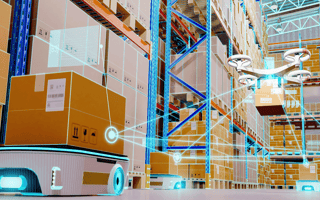You’ve got your tuggers, your pickers and your stackers.
These autonomous mobile robots (AMRs) are performing simple tasks — often transporting goods and materials from point A to point B — everywhere from car factories to fulfillment centers.
What Is an Autonomous Mobile Robot?
An autonomous mobile robot (AMR) is a robot capable of navigating its surrounding environment without human oversight. AMRs are typically designed with sensors and other technology so they can safely avoid obstacles in their environment while continuing with their assigned task.
What Is an Autonomous Mobile Robot?
An autonomous mobile robot is a robot that is able to navigate within, and respond to, its environment without humans directly controlling it.
Equipped with sensors so they can steer clear of obstacles and connect with other robots and networks, AMRs are preprogrammed before use — typically by mapping their working environment to create transport paths. They offer more flexibility than automated guided vehicles (AGVs), which rely on track-like systems made of wires, magnets or lasers to move along a fixed route.
AMRs work everywhere from warehouses and other logistics facilities like fulfillment centers, to manufacturing and production centers, and even construction sites. They also work in homes vacuuming floors, and in the sky where they’re delivering food, groceries and other retail items.
Why Are Autonomous Mobile Robots Used?
AMRs have become a common sight in various workplaces because they offer benefits that distinguish them from other technologies like AGVs.
Benefits of Autonomous Mobile Robots
- Increases productivity.
- Improves worker safety.
- Supports greater adaptability than AGVs.
- Adapts to changing business needs.
Increased Production
AMRs are able to complete the manual labor humans typically do without getting fatigued, and some models can work around the clock. These traits allow AMRs to boost a business’ production while delivering consistent, high-quality work. At the same time, the automation of repetitive and mundane tasks frees up human workers to spend their energy on more challenging business needs, resulting in a more efficient workforce.
Improved Worker Safety
Many autonomous mobile robots are built to handle extreme conditions in sectors like energy, construction and manufacturing. They can handle heavy-duty tasks without tiring, saving human workers from having to endure stressful situations. Together, these factors reduce the likelihood of errors and workplace injuries, contributing to better physical and mental health for employees throughout their careers.
Greater Adaptability
While AGVs fulfill functions similar to those of AMRs, they are locked onto predetermined routes. This means they stop if an obstacle is blocking their path and wait for it to be removed. AMRs demonstrate more flexibility, sensing a person or object in their path and then going around to continue their task. AMRs can also map out routes on their own, adapting to environments like crowded hospital hallways and dynamic construction sites.
Longer-Term Scalability
The ability of AMRs to act on real-time decisions and adapt to changing variables means they can handle new tasks, workflows and workplaces. If a business decides to reprioritize its needs or expand to another location, it can easily integrate its AMR fleet into these plans without requiring teams to perform much reprogramming.
Types of Autonomous Mobile Robots
While many AMRs are used in the service sector where they’re disinfecting high-touch areas, serving drinks in casinos or delivering room service in hotels, they’re making the biggest impact behind the scenes working in industries like logistics, manufacturing, and e-commerce.
Industries That Use Autonomous Mobile Robots
- Logistics
- Manufacturing
- E-Commerce
- Hospitality
- Healthcare
- Construction
- Agriculture
- Energy
Here are a few of the most common types in operation today:
Picking Robots
These AMRs follow a goods-to-person operation model, transporting goods and materials from one location to another where humans can pick and fulfill orders. Picking robots eliminate much of the walking associated with human-led order fulfillment, delivering items a worker needs when they need it, boosting productivity and increasing efficiency.
Self-Driving Forklifts
Often found in warehouses moving and stacking pallets and other items, self-driving forklifts are another common AMR operating in the logistics industry where they play a key role in managing storage space. They’re also playing a crucial role in an industry struggling to find workers. “Demand for logistics help is soaring, but forklift operators and other skilled workers are in short supply,” Joann Muller wrote in a 2022 Axios article. “Robotic vehicles are one way that manufacturers and logistics companies can address labor shortages while running their operations more safely and efficiently.”
Autonomous Inventory Robots
Many of these robots help companies manage their inventory by tugging materials and goods quickly and safely. Paired with RFID tags, a wireless tracking device that can be attached to supplies and products, these robots can navigate storage areas to help companies keep better track of inventory.
Delivery Robots
From hot plates to packages, delivery AMRs are gaining popularity, with the industry set to reach $1.8 billion in value by 2028. Some delivery robots may come in the form of drones or compact vehicles with secure compartments. These robots are typically used for last-mile delivery or curbside pickup for things like food orders, groceries and packages.
Hospitality Robots
Restaurants and hotels can reap the benefits of autonomous mobile robots too. AMRs in these industries are typically used for delivering food to tables in restaurants, cleaning floors in hotels and even making deliveries to guests’ rooms. Although these robots are still somewhat niche, future innovations may help them become more mainstream.
Disinfection Robots
Autonomous mobile robots can help keep healthcare spaces clean. UV disinfection robots travel through hospital corridors and rooms to sanitize high-touch surfaces like light switches, door handles and assistive rails with special UV light bulb attachments to kill bacteria, viruses and germs.
Construction Robots
Some AMRs are built specifically for the construction industry, displaying the frame needed to withstand rugged terrains and maneuver through busy spaces. These robots can also automate certain tasks like drawing layouts along surfaces for workers to reference. They can even add labels as well to help workers keep track of information and plan accordingly.
Agricultural Robots
Robots in the agricultural industry combine sensors and cameras with GPS technology to navigate farms while distinguishing between different objects. As a result, they can autonomously harvest crops, plant seeds, eliminate weeds and apply fertilizer. Larger agricultural AMRs include autonomous tractors, which can perform these same tasks on a broader scale to serve the needs of larger farms.
Quadruped Robots
While quadruped robots are versatile and able to operate in many workplaces, they have a major impact in the energy sector. Sites like power plants and oil platforms can have tight spaces, stairs and slippery surfaces. The more athletic and balanced frame of quadrupeds enables them to traverse these difficult environments. They can then perform more dangerous tasks like collecting visual data in unsafe areas to inform teams’ actions ahead of time.
Drones
Unmanned aerial vehicles, or drones, can work as autonomous mobile robots, too. As AMRs, they’re typically found inspecting hard-to-reach areas like dams and other infrastructure, conducting surveillance or helping out in search and rescue operations. In some areas, you may even see them flying through the air delivering food and other items.
Autonomous Mobile Robot Developers
As autonomous mobile robots continue to expand their reach in industries ranging from logistics and manufacturing to hospitality and healthcare, here are a few companies that will continue to push AMRs to the next level.
Location: Kyoto, Japan
OMRON’s automation branch has developed complementary AMRs designed to take on a variety of tasks. While a 1,980-pound payload makes MD Series robots great for transporting medium-sized items, pallets and raw materials, LD mobile robots are more flexible and ideal for smaller, more populated hallways. The OMRON team is also working on expanding its lineup with an HD-1500 robot that boasts a payload capacity of around 3,300 pounds.
Location: Zürich, Switzerland
ABB’s autonomous mobile robots are able to help companies manage their storage and transport materials more efficiently. In 2021, ABB acquired ASTI, a leading AMR company, and rebranded and launched its AMR line as Flexley. ABB’s offerings include Flexley Tug, which is used in assembly applications, like bringing a car chassis into a robot cell; Flexley Mover, which is used for delivering racks, boxes and containers in tight spaces; and Flexley Stack, a mobile robotic forklift that can move pallets and containers for shipping and receiving and production line applications.
Location: San Jose, California
Acquired by Zebra in 2021, Fetch Robotics’ autonomous mobile robots can be found in manufacturing facilities and fulfillment and distribution centers where they’re delivering material, picking orders and managing storage space. The company’s line of AMRs include robots that can transport carts, collect totes and bins and carry packages. Fetch Robotics even has a robot model designed specifically for teaching and research settings.
Location: North Reading, Massachusetts
A subsidiary of the automation company Teradyne, Mobile Industrial Robots designs AMRs for logistics and manufacturing facilities, working with companies like IKEA and Novo Nordisk in China. The company, which merged with AutoGuide Mobile Robots, offers a diverse selection, ranging from the more nimble MiR250 to the sturdier MiR1350 that can handle nearly 3,000 pounds.
Location: Ontario, Canada
AMRs developed by OTTO Motors are designed to transport goods and materials between people, racks, shelving and other equipment. The company worked with Mauser Packaging Solutions, a global packing company, replacing its old AGV system with the OTTO 1500 in a few of their facilities. At one facility, Mauser reported being able to shift three employees to focus on more important tasks and improved safety since manual forklift traffic was reduced. It has also increased throughput by 600 percent at another facility.
Location: Roswell, Georgia
GreyOrange offers a range of mobile robot solutions for warehouse settings. The company’s AMRs include robots that retrieve inventory, transport goods across warehouses, optimize storage space for items, sort through packages and act as mobile forklifts. Keeping all the moving parts in sync is GreyOrange’s orchestration platform, which makes mobile robots’ workflows as efficient and productive as possible.
Location: Waltham, Massachusetts
Boston Dynamics first made waves with its Big Dog robot, and its AMRs have since evolved into reliable coworkers. Stretch is a mobile robotic arm that can handle different types of packages up to 50 pounds, detect and pick up fallen packages and execute real-time decisions. While Stretch is best for warehouses, Boston Dynamics’ Spot features an agile frame and can fulfill roles unsafe for humans in the energy and construction industries.
Location: Shelby Township, Michigan
KUKA has crafted a trio of intelligent AMRs that work side-by-side with humans. The KMR iisy cobot uses cameras and scanners to complete its duties and prevent workplace accidents. For more complex tasks, the KMR iiwa can adapt to dynamic environments and perform delicate actions like handling semiconductor wafers. And for jobs that require more muscle, the KMR QUANTEC can lift hefty materials while being able to maneuver in all directions.
Location: Wilmington, Massachusetts
The line of AMRs from Locus Robotics is used in settings ranging from warehouses to industrial and manufacturing facilities. Origin, which can be used to transport up to 80 pounds of goods in bulk bins and shipping boxes, is customizable for different levels of shelving. It uses LIDAR and vision technology for navigation, plus eight sensors and cameras along with a tablet-based interface. Vector, which is used for picking and transport applications, has a secure shelf system and can carry up to 600 pounds.
Location: Redwood City, California
Drone manufacturer Skydio develops autonomous drones used in applications ranging from inspection and security to construction site mapping. Their X2 drone uses GPS navigation and is equipped with strobe lighting, six navigation cameras and onboard artificial intelligence capabilities. With a 35-minute flight time, the X2 can also be used for search and rescue, intelligence and incident response applications.
Location: San Francisco, California
Starship Technologies produces autonomous delivery robots for carry-out food, groceries and small packages. The company even has its own food delivery app where customers can order from local restaurants. Starship delivery can be found in 60 locations and has completed over 6 million autonomous deliveries, according to its website.
Location: Waltham, Massachusetts
Vecna Robotics speeds up the workflows of manufacturing and warehouse workplaces with its slate of mobile robots. Autonomous forklifts can lift goods as much as five feet in the air, autonomous pallet trucks can put away inventory, pallet jack cobots can transport goods as needed and autonomous tuggers can make runs to restock items. With the company’s Pivotal platform, teams can track and analyze these movements to optimize their processes.
Location: Mountain View, California
Working in the construction industry, Dusty Robotics’ FieldPrinter is able to print layouts for different projects ranging from parking garages and data centers to hospitals and office buildings, a job that traditionally involves humans and chalk lines. The FieldPrinter is able to print precise layouts on concrete, plywood subfloors and asphalt and even adds text labels to printed layouts to ensure important design information doesn’t go unnoticed.
Location: Pittsburgh, Pennsylvania
Outfitted with biometric security and pin code access, Aethon’s autonomous robots work across healthcare settings, securely transporting critical care needs like medication, lab specimens and surgical supplies. The T3 series displays agility in tight spaces while hauling up to 750 pounds, and the Zena RX has roomy storage space for larger supplies. Meanwhile, Aethon’s Zena can connect to elevators, making it ideal for providing hospitality services.
Location: Odense, Denmark
Blue Ocean Robotics’ UVD cleaning and disinfecting robot works in high-traffic and high-touch areas like offices, hospitals, airport bathrooms, schools and retail stores. By emitting UV-C, or shortwave light, it’s able to kill bacteria by damaging their DNA and RNA. The company also has a PTR robot that facilitates physical rehabilitation and training.
Location: Kraków, Poland
For businesses that want to have a hand in the design of their own AMRs, Husarion offers software and robotic plans for customized development, allowing clients to make modifications based on use case. Husarion’s Panther platform, for example, is designed for use outdoors in applications ranging from agriculture, rescue and inspection. It features LIDAR technology for navigation, and other features like GPS and robotic arms can be added.
Location: Westlake Village, California
InVia Robotics’ Picker robots retrieve and move items using an extendable lift to reach higher shelves and an industrial suction cup to grip goods. It’s able to carry a payload up to 40 pounds and has a reach of eight feet. Self-charging with built-in lighting technology, the company’s Picker robots can travel at a maximum speed of 5 miles per hour and have a battery life of 10 hours. InVia also uses a robotics-as-a-service business model, leasing their robots to companies, which reduces initial investment costs for clients.
Location: Valencia, Spain
Robotnik designs and develops AMR platforms for research and transport, and it has two separate lines of mobile robots. All the company’s robots are able to move in any direction and are equipped with lasers and sensors to interact safely with humans. Robotnik’s robots are also easy to set up and are controlled by user-friendly interfaces.
Location: Shenzhen, China
Syrius Robotics possesses a slate of mobile robots that are designed for distribution centers, warehouses and other logistics settings. The FlexSwift robot is ideal for sorting and transporting items while the FlexPorter GO can manage larger items for purposes like shelving and picking. For heavy-duty tasks, the FlexPorter DO is the best option, featuring a payload capacity of over 2,000 pounds. Fleets of these robots can be coordinated with Syrius Robotics’ AMR platform, making workflows more efficient.
Location: Santa Clara, California
AMRs developed by Techmetics Robotics work in healthcare, assisted living facilities and hotels. In casinos, the company’s AMRs are able to carry and deliver valuable chips and cards. For added security, the robot features three-layer compartments. The company’s Techi Food Cart and Techi Drinks Serve also deliver food and drinks to gamblers. There’s even a Techi Concierge that guides gamblers to tables and makes reservations. In hotels and other hospitality settings, the Techi Concierge is able to sell tickets, answer questions and offer instructions for specific tasks.
Location: Longmont, Colorado
Scythe Robotics’ autonomous, all-electric mowers use sensors and AI to navigate terrain while avoiding obstacles. They’re designed to be quieter than they’re gas-powered counterparts, adjust to changes in grass thickness and reach a maximum speed of 10 miles per hour. By using these machines, Scythe says crews can expand their workforce’s capacity and improve productivity without having to hire additional help.
Location: Seattle, Washington
Carbon Robotics makes automated robots for farming operations. Its LaserWeeder product comes with AI and computer vision capabilities that enable them to accurately differentiate between crops and weeds. The robots then use high-powered lasers, rather than chemicals, to destroy the weeds. Carbon Robotics says its solutions can save farmers money on manual labor and improve soil health, which can lead to better crop yield. The LaserWeeder can be controlled through a mobile app that has tools for monitoring machine location and performance.
Location: Boston, Massachusetts
Piaggio Fast Forward’s gita line of compact, cargo-carrying robots are equipped with “dynamic following technology” that ensures they follow closely behind their owner and can adjust to pace as needed. The company says its machines are engineered to be able to safely navigate around obstacles and other pedestrians. The gitaplus model has a carrying capacity of up to 40 pounds, while the smaller gitamini model is able to move up to 20 pounds.
Autonomous Mobile Robot Use Cases
Location: Wayzata, Minnesota
Cargill offers ingredients and products for beauty, food, industrial and agriculture industries. At its multiseed crush and refinery plant in Amsterdam, it has a four-legged robot dog named Spot that supports industrial safety and predictive maintenance. It performs more than 10,000 weekly inspections, capturing thermal, acoustic and visual data.
Frequently Asked Questions
What is an example of an autonomous robot?
Autonomous vacuums, pallet trucks and forklifts are a few examples of autonomous mobile robots.
How do AGV robots work?
Automated guided vehicles (AGVs) are equipped with software that can store instructions shared by human users, allowing AGVs to memorize preset routes. Once in action, AGVs rely on a system of cameras, sensors and LIDAR to navigate different environments while sensing when objects and people are blocking their path.
What is the difference between AMR and AGV?
Unlike AMRs, AGVs can only follow predetermined paths. If an obstacle is in the way of this path, an AGV can’t go around it and will stay in place until someone removes the object. AMRs are more adaptable and can maneuver around objects to continue their tasks.

























